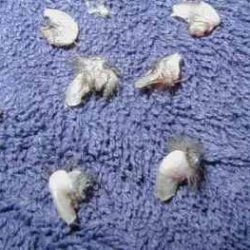Having read and thought about the title to this article, are you really sure that you want to declaw your cat? If you have doubts then please read on and see what other consequences there are to this controversial and unnecessary veterinary operation.
Please click on the images to see larger versions. Also please ‘like’ this page to spread this information around as it is vital in the interests of domestic cats in America.
A study has been published on the Popular Science website. It concerns declawed cats. There are hundreds of pages on cat declawing on this website. All of them decry and criticise the process. Part of the problem is that the word “declawing” implies that the cat’s claw is removed, which of itself would be bad enough but the truth of the matter is that a lot more than the cat’s claw is removed. The ends of their toes are removed up to the first joint.
Cats which have been declawed are known to chew at the stubs of their paws. This is due to pain and an attempt to alleviate it. People ask whether the declawing process hurts cats. You ask any vet tech whether declawing hurts cats and I am sure that most of them will say that the cats climb the walls in pain after the operation even having been given strong pain killing medication. Let’s not forget that the veterinarian amputates the ends of 10 toes, all in one go, and they usually do this in about 20 minutes. Some operations go wrong. In fact a high percentage go wrong which can leave shards of bone in the paw with consequential long-term pain which can then have a detrimental effect upon the cat’s gait, which in turn can have a detrimental effect upon other parts of the cat’s anatomy (see below).
Anyway, back to the statement in the title to his article. The study referred to found that declawed cats were seven times more likely to pee inappropriately which means outside of the litter box. They were also four times more likely to bite people and three times more likely to be aggressive. Finally, they were also three times more likely to over-groom themselves. Over grooming is usually a sign of stress because grooming eases stress.
I mentioned above, in the previous paragraph, how declawing can affect a cat’s gait by which I mean the manner in which they walk. The study also found that declawed cats were more likely to suffer from back pain. It goes without saying that declawed cats were also far more likely to suffer chronic pain in their paws.
Declawed cats, because their paws are tender, prefer to urinate on soft surfaces i.e. carpet or clothing. They find the usual cat litter uncomfortable to use. This is why cat owners use paper in the little box after their cat has come back from the clinic. There is even a commercially manufactured post-declaw cat litter! Talk about parasitic behavior.
Because a declawed cat is unable to use their claws they are more prone to biting and as there is more bacteria in a cat’s mouth than there is on a cat’s paw, biting a person is more likely to infect a bitten person which may lead to the need for antibiotics and even in extreme cases hospitalisation if the wound is left untreated.
The number of cats participating in this study was 274. They were of various ages and half of them had been declawed. They studied cats in shelters and cats who had been brought veterinarians’ clinics.
The lead author of the study is a Texas veterinarian and a director of the Paw Project, Nicole Martell-Moran. Well done and thanks.
There are numerous alternatives to declawing. The best alternative is for the cat’s owner to get used to a cat’s claws and to avoid being scratched. This is about a cat owner learning how to be the caretaker of a whole cat who has retained his claws. It is not difficult.
Link to the Popular Science article.
P.S. At the base of this page below the image links just below are tags which are more links to more pages on declawing. All aspects are covered.





